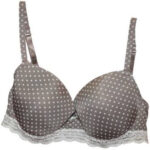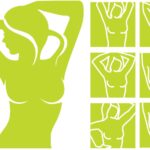Breast Health: General Information
Key Facts
- Breasts come in many shapes and sizes.
- Although most lumps or changes in your breast(s) are normal when you’re a teen, see your health care provider if you notice any new changes or lump(s).
- A well-fitting bra helps prevent breast discomfort, back pain, and shoulder pain.
 Women’s breasts come in many shapes and sizes. There is no perfect shape or size for breasts. Normal breasts can be large or small, smooth or lumpy, and light or dark.
Women’s breasts come in many shapes and sizes. There is no perfect shape or size for breasts. Normal breasts can be large or small, smooth or lumpy, and light or dark.
Your breasts start growing when you begin puberty. During puberty the hormone levels in your body change, which causes your breasts to develop and your periods to start. Many factors affect when you are going to begin puberty and develop breasts, including heredity (the way certain characteristics are passed down from generation to generation), weight, exercise, nutrition, stress, and chronic illnesses.
How do breasts develop?
The inside of your breasts is made up of fatty tissue and milk-producing glands, called mammary glands. The dark area of your breast around your nipple is called the areola. As your body starts to develop, a small lump grows under the areola and nipple. This lump is called the breast bud. As the buds get larger and rounder, the breasts grow.
As your breasts develop, the areolae get bigger and darker. Areolae and nipples can range in color from light pink to purplish to light gray depending on your skin color.
When will I get breasts?
Your breasts start growing when you begin puberty and the hormone levels in your body change, causing your breasts to develop and your menstrual periods to start. Heredity (the way certain features are passed down from generation to generation), nutrition, weight, exercise, and chronic illness determine when you are going to begin puberty and develop breasts. Most girls’ breasts begin growing when they are about 9 or 10 years old, but some girls may start developing breasts earlier or later than this age.
How long will it take to get breasts?
It takes different people different amounts of time to develop breasts, usually between 3 and 5 years. The age when you start to develop does not have an effect on the final size of your breasts. For example, if you develop earlier than most girls, this doesn’t mean that you will have bigger breasts than most girls.
Does everyone develop breasts at the same time?
No. It’s normal for some girls to start to develop breasts when they’re 8 or 9 years old, while others don’t start until they’re 11 or 12. Every girl has her own “clock” that her body follows. For example, girls who do gymnastics, dance, track, or another very active sport may go through puberty at a later age. Even if your development is normal, it can be hard if you seem to be either the first or the last one among your classmates or friends to develop breasts. Talk to a parent or an adult that you trust and tell them how you are feeling. If you develop early, remember that other girls will soon catch up.
Is there anything I can do to increase the size of my breasts?
Heredity is the most important factor in determining breast shape and size. No creams, special exercises, or clothing will permanently change your breast size. Your breasts may change with weight loss or gain or after a pregnancy, but for the most part, the size of your breasts stays the same once you’ve finished puberty. Also, breast size has no effect on whether a woman will be able to breastfeed her baby.
When and how will my breasts make milk?
Inside a woman’s breasts are tiny pockets called alveoli. After a woman gives birth, her brain’s hormones tell the alveoli to produce milk. When her baby sucks on her nipple, the sucking draws milk from the alveoli through the milk ducts and out small holes in the nipple. When the mother stops breast-feeding her baby, her alveoli slowly stop making milk.
Normal Breast Development
My breasts are uneven. Is this normal?
It’s very common for your breasts to grow at different rates while they’re developing. Usually, they’ll look about the same size by the time they’re done growing. If you have a size difference and it bothers you, try a foam or gel insert that fits into your bra or bathing suit. These inserts are sold at specialty bra and lingerie shops and in department stores.
Most women have breasts that are not exactly the same size. However, sometimes breasts can be noticeably uneven (different by more than a cup size) after you have started your periods and your breast development has finished (3-5 years from when they started developing). If you are unhappy about the difference in your breasts’ sizes, you can talk with your primary care provider about using gel inserts and about the benefits and risks of corrective surgery.
My breasts are very large, and they make my back hurt because they’re so heavy. It’s also hard to exercise, because I get sore breasts. What can I do?
Some girls feel that their breasts are too large. Often, they’re not worried about how they look, but they’re bothered by breast pain, back pain, shoulder pain, dents in the shoulders from bra straps, rashes, skin problems under the breasts, or difficulties with exercising. Girls can also feel badly or self-conscious if they are teased about their large breasts.
If your breasts are very large, there are some options that can help.
- First, find a well-fitting bra to minimize and support your breasts. Look for a bra that has wide shoulder straps and supportive cups. If you need help with measuring for a bra, see a trained salesperson working at a department store or a lingerie store for help.
- If you are overweight, working to reach a healthy weight may also help.
- The last option is to have breast reduction surgery. This type of surgery, which is done by a plastic surgeon, removes some of the extra breast tissue to decrease pain. It’s a serious decision and operation. Talk to your primary care provider to get more information.
Is it normal to have hair around my nipples?
Some girls have hair around their nipples. This is completely normal. If the hair bothers you, it’s best to cut it with small scissors. Plucking or shaving the hair can cause infection.
My nipples point inward instead of out. Is this normal?
If your nipples point inward instead of out, you have “inverted nipples.” Between 10%-20% of all girls have an inverted nipple on at least one breast. This is normal and will not affect your health in any way. If you have inverted nipples, it’s important to keep them clean to avoid getting an infection in the folds of skin around your nipple.
What are stretch marks? Are they normal?
Stretch marks are red or purplish spoke-like lines that appear on the skin during times of rapid physical growth (such as puberty or pregnancy). During puberty, stretch marks on the breasts are very common and completely normal. Other common places for stretch marks are on the hips and thighs. Over time, the stretch marks will fade to match your normal skin color.
If I have a rash around the nipple area on my breasts, does that mean that my breasts are infected?
Usually, yes. A rash can be a sign of an infection, especially if one breast is swollen and tender, if there’s discharge, or if you have a fever. You can also get a rash on the skin under your breasts, which is usually either a heat rash or a yeast infection. If any of these signs of infection are present, call your primary care provider. Sometimes a hair root around your nipple area can become infected. When this happens, one or more tiny red bumps appear. The tiny red bumps are called folliculitis.
Is breast pain or tenderness normal?
You may feel a tingling or aching in your chest when your breast buds start developing. After you start to get your periods you may notice that your breasts become tender or sore a few days before you get your period each month. Not everyone has soreness. If your breasts are tender, check with your primary care provider. Your HCP may suggest taking over-the-counter pain medicine (such as ibuprofen) to help with the symptoms. Older teens who are bothered by breast pain before periods may benefit from taking low dose oral contraceptive pills. Some, but not all, individuals have found relief after quitting caffeine.
What if I have a discharge coming from my breasts?
Discharge from your breast(s) could mean that your breast(s) are infected, that a breast duct is dilated (widened), or that you have a hormone imbalance. The discharge may be on just one side or from both breasts. When a milky discharge comes from a young woman’s breast when she is not breast feeding, it’s called galactorrhea. This condition can result from taking certain medications such as birth control pills or medicine for mood disorders, from being pregnant or recently being pregnant, from low thyroid hormone levels, or rarely from a benign (not cancerous) pituitary tumor. Your body may be making extra amounts of prolactin, which can cause galactorrhea. A brown or bloody discharge may come from dilated breast ducts or small polyps in the breast ducts or glands beneath the areola (Montgomery glands). There may also be a blue area under the nipple. A small amount of yellow discharge sometimes occurs around the time a girl starts her period. You should call your primary care provider if you have breast discharge and/or local breast tenderness, pain, redness, or fever.
I have small bumps around my nipple. Is this normal?
These bumps are normal. The medical term for them is “periareolar glands of Montgomery.” They play a role during lactation (during the time when a woman’s body makes breast milk). If these glands become inflamed, red, and/or you notice drainage of clear to brownish fluid, you should make an appointment with your health care provider.
